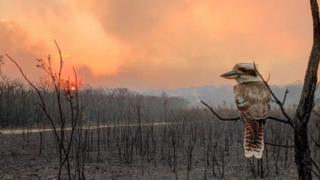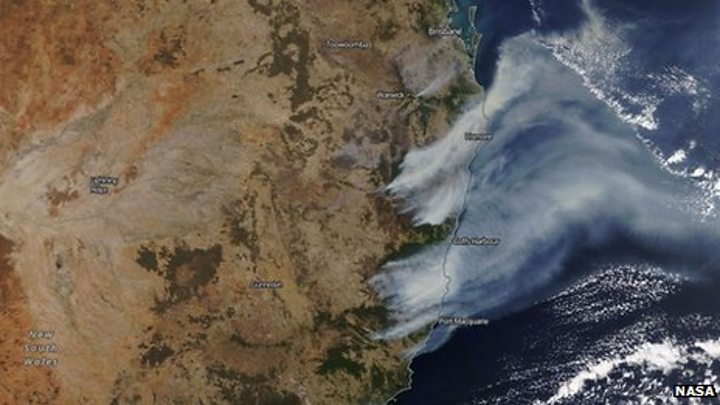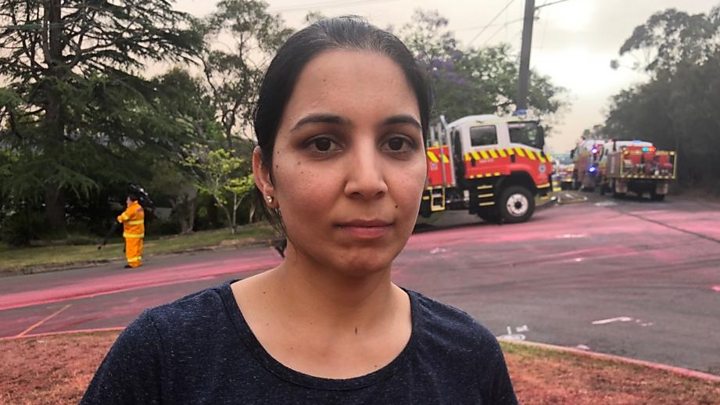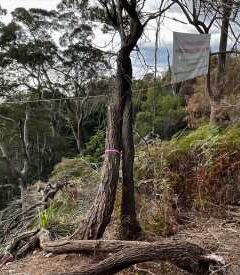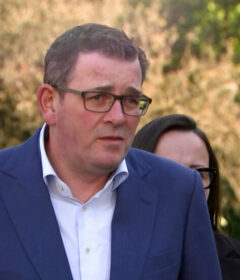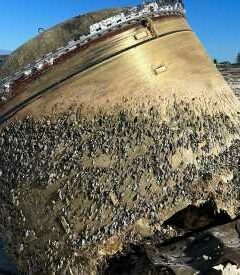Home » Australasia »
Worst of Australia’s bushfires ‘still ahead’
Australian authorities have warned that massive bushfires raging in two states will continue to pose a threat, despite “catastrophic” conditions easing.
About 150 fires are still burning in New South Wales (NSW) and Queensland, feeding off tinder-dry conditions.
Fifty houses were destroyed or damaged in NSW on Tuesday but no lives were lost, officials said. At one point, fires broke out in suburbs of Sydney.
On Wednesday, blazes caused fresh emergencies in Queensland.
“The conditions are of concern to us,” Premier Annastacia Palaszczuk told reporters.
The threat in NSW has been downgraded from catastrophic – the highest level – but officials urged residents to remain vigilant.
“We’ve got the worst of the summer – the worst of the season – still ahead of us as we head into summer,” said NSW Rural Fire Services Commissioner Shane Fitzsimmons.
Australia’s government has often avoided questions on whether climate change could have contributed to the fires, in a response that has drawn criticism.
What’s happening in Queensland?
More than 60 bushfires are burning in the state amid forecasts of high temperatures, volatile winds and dry lightning.
Residents in Noosa North Shore, on the popular Sunshine Coast, were among those to be issued emergency warnings on Wednesday.
A water-bombing helicopter crashed while fighting a fire at Pechey, west of Brisbane, but the pilot survived with only minor injuries.
Officials warned that no significant rain was expected, putting continuing strain on firefighters.
What about NSW?
Mr Fitzsimmons said it was a relief that no-one died on Tuesday given “the enormity of these fire grounds”. About 1.1 million hectares have been scorched in NSW since September.
The worst fires dot NSW from its northern border to a national park north of Sydney. Though perimeters constantly shift, most are in populated coastal zones or further inland.
Since Friday, three people have died and up to 200 homes have been razed.
Flame retardant had to be dropped in Sydney’s northern suburbs as some bushfires approached within 15km (nine miles) of the city centre.
A firefighting plane dropped pink fire retardant in the area between Macquarie University and the Sydney Adventist Hospital in the South Turramurra suburb.
One resident who evacuated, Diksha Anand, told the BBC she had feared losing her house.
Actor Russell Crowe tweeted that his property had been damaged, but he was overseas and his family was safe.
Mr Fitzsimmons said 3,000 firefighters were on the front lines, boosted by crews from other states and New Zealand, as well as the Australian Defence Force.
Is this linked to climate change?
Scientists and experts warn that Australia’s fire season has grown longer and more intense due to climate change.
Officials have confirmed that 2018 and 2017 were Australia’s third and fourth-hottest years on record respectively, and last year the nation experienced its warmest summer on record.
The Bureau of Meteorology’s State of the Climate 2018 report said climate change had led to an increase in extreme heat events and raised the severity of other natural disasters, such as drought.
Even if global temperatures are contained to a 2C rise above pre-industrial levels – a limit set out in the landmark Paris accord, agreed by 188 nations in 2015 – scientists believe the country is facing a dangerous new normal.
Last year, a UN report said Australia was falling short in efforts to cut its CO2 emissions.
Have you been affected by the bushfires? Share your experiences by emailing [email protected].
Please include a contact number if you are willing to speak to a BBC journalist. You can also contact us in the following ways:
Or use the form below:
If you are happy to be contacted by a BBC journalist please leave a telephone number that we can
contact you on. In some cases a selection of your comments will be published, displaying your name as
you provide it and location, unless you state otherwise. Your contact details will never be published.
When sending us pictures, video or eyewitness accounts at no time should you endanger yourself or others,
take any unnecessary risks or infringe any laws. Please ensure you have read the terms and conditions.
Terms and conditions
The BBC’s Privacy Policy
Source: Read Full Article
